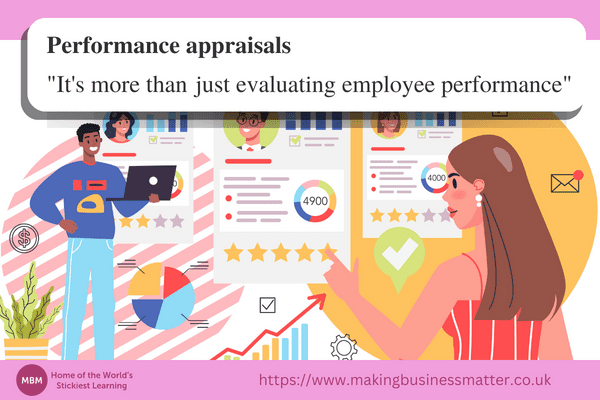Managers: You Hold the Key to 70% of Employee Engagement. Here’s One Secret to Unleashing the Untapped Potential of Team Spirit!
Did you know that a staggering 70% of an employee’s engagement is influenced by their manager? This statistic highlights the profound impact that performance appraisals, when conducted effectively, can have on a team’s motivation and productivity.
I’ve seen firsthand how a manager’s approach to performance appraisals can make or break the team spirit. Performance appraisals can be intimidating, both for managers and employees. However, they are an essential part of any organisation’s performance management system.
All managers need to know how to do an appraisal. A well-conducted performance appraisal can provide valuable feedback to employees, help identify areas for improvement, and recognise strengths and achievements.
It’s important to approach performance appraisals with a positive attitude and a focus on constructive feedback. In this article, we’ll explore the key steps in conducting an effective performance appraisal and provide practical tips to make the process smoother and more meaningful for you and your employees. So, let’s dive in and learn how to master the art of performance appraisals!

Table of Contents
1- Why Prioritise Performance Appraisals?
2- Purpose of an Appraisal
3- How to Write an Appraisal in 7 Steps
4- Performance Appraisal Methods: Enhancing Employee Evaluation
5- Objective Performance Evaluation System
6- When and How Often to Run Employee Performance Appraisals
7- The Importance of Objectivity in Performance Evaluation Systems
8- Dealing With Difficult Appraisal Performance Situations
9- Appraisal Results’ Performance Plan
10- Continuously Improving the Performance Appraisal Process
11- Conclusion
Why Should Managers Prioritise Performance Appraisals?
Simply put, they are a cornerstone of employee engagement. Managers are not just supervisors; they are also pivotal in shaping the work environment and the overall experience of their team members. By providing regular, meaningful feedback, managers can foster a culture of growth and also recognition, which in turn can lead to:
- Increased Engagement: Regular, meaningful feedback leads to employees who are three times more engaged. Engaged employees are the ones who innovate and also drive your company forward. “Engagement is not something you do to employees; it’s something you inspire in them,” says Paul Marciano, a respected authority on employee engagement. This aligns with the idea that performance appraisals should be a cornerstone of employee engagement.
- Lower Turnover Rate: Feeling valued and understood can reduce turnover rates by 14.9%. Rob Burn, President of L & L Solutions, emphasises that “Performance should be an expectation of employment and it is the leaders’ job to create an environment where maximum performance is possible.” This reflects the importance of performance appraisals in creating an environment where employees feel valued and understood, which can significantly reduce turnover rates.
- Higher Profitability: Engaged teams contribute to a 23% increase in profitability. “Performance management continues to be an important cornerstone of business and individual growth and development,” states Sameer Nagarajan, Global President- HR at Cadila Pharmaceuticals.
Purpose of an Appraisal
Performance appraisals are a critical tool for managers and organisations to assess employee performance and provide feedback. However, it’s essential to understand that the purpose of performance appraisals goes beyond just evaluating employee performance.

One of the main objectives of performance appraisals is to help employees identify their strengths and areas for improvement. Furthermore, it allows them to understand how their work contributes to the overall goals of the organisation, and how they can improve to achieve those goals more effectively.
Frank V. Cespedes, a senior lecturer at Harvard Business School, emphasises that “People become high performers by identifying specific areas where they need to improve and then practising those skills with performance feedback.” Apart from this, there are two other purposes of the performance appraisal:
Sticky Learning ® is 7 times more effective than 1-day training courses. Plus, you will get a Chain of Evidence proving your Return on Investment. Discover soft skills training that changes behaviours long term.

#1. Setting Performance Expectations
An essential purpose of performance appraisals is to establish clear and specific performance expectations. By setting expectations, managers can help employees understand what is expected of them and also how they can work towards achieving their goals.
#2. Employee Development Based on Results
Performance appraisals also play a vital role in employee development. By providing feedback on performance, managers can identify areas where employees need additional training or support. Also, it can help create an actionable development plan to improve skills, knowledge, and abilities. Moreover, it can also help identify high-potential employees who may be suitable for leadership or management roles.
#3. Recognition and Reward
Finally, performance appraisals can also serve as a tool for recognising and rewarding employee contributions. “A good performance appraisal and reward system encourage employees to work on company goals,” states Bizfluent, emphasising the motivational aspect of recognition. By acknowledging their hard work, managers can motivate employees to continue performing at a high level. It can also help build employee morale, loyalty, and commitment to the organisation.
How to Write an Appraisal in 7 Steps

Step 1: Establish Performance Expectations
The first step in any appraisal process is to establish clear and specific performance expectations. By providing employees with clear expectations, managers can help them understand what they need to achieve and how their work contributes to the organisation’s success. For example, clearly outline the key objectives and metrics for a sales representative, such as achieving a certain number of sales per month or maintaining a high customer satisfaction rating.
Step 2: Provide Ongoing Feedback
Regular feedback throughout the year is critical for employee development and improvement. Managers should provide feedback on an ongoing basis, highlighting areas of strength and opportunities for improvement.
This approach helps to create a more collaborative and supportive work environment where employees can continuously improve their performance. Schedule regular one-on-one meetings with employees to discuss their progress, offering praise for meeting goals and constructive feedback for areas needing improvement.
For instance, if a graphic designer consistently produces high-quality work, commend their attention to detail, while gently suggesting ways to enhance creativity.
Step 3: Conduct the Appraisal Meeting
The actual appraisal meeting is where managers provide a formal evaluation of an employee’s performance over a specific period. The goal is to have a productive conversation that enables the employee to understand their performance and the expectations for the next appraisal period. Set aside dedicated time for an annual performance review where you and the employee can discuss achievements, challenges, and goals for the upcoming year. This might involve discussing how a marketing manager’s campaigns contributed to increased brand visibility and sales.
Step 4: Discuss Strengths and Opportunities
During the appraisal meeting, managers should discuss both an employee’s strengths and opportunities for improvement. By focusing on strengths, managers can recognise and reinforce positive behaviours and traits, while also encouraging employees to continue building on those strengths. Identifying areas of opportunity, meanwhile, helps employees understand where they can improve and develop new skills.
For instance, highlight a software developer’s proficiency in coding languages and problem-solving skills during the appraisal meeting. Simultaneously, address areas like time management or communication skills where improvement could enhance overall effectiveness.
Step 5: Create an Action Plan
The appraisal meeting should conclude with the creation of an action plan. This is a plan of action that outlines specific steps employees can take to improve their performance over the next appraisal period.
The plan should be specific, measurable, achievable, relevant, and time-bound (SMART). It should also take into account the employee’s strengths and opportunities for improvement identified in the appraisal meeting. Collaborate with the employee to develop a plan for skill enhancement or goal attainment.
For instance, if a customer service representative struggles with handling difficult customers, outline steps such as attending communication workshops or shadowing seasoned colleagues to learn effective de-escalation techniques.
Step 6: Follow-up and Monitor
After the appraisal meeting, managers should follow up with employees to ensure that they are on track with their action plans. This provides an opportunity to offer additional support or guidance and address any issues that may arise. It also helps to keep employees accountable for their performance and development. Schedule periodic check-ins to review progress on the action plan and provide support as needed.
For example, if a project manager is committed to improving team communication, monitor whether they implemented suggested strategies like regular team meetings or adopting collaboration tools.
Step 7: Continuously Improve the Appraisal Process
Managers should seek feedback from employees on their experience with the appraisal process, identifying areas for improvement and making adjustments as necessary. By continuously improving the appraisal process, organisations can ensure that it remains a valuable tool for employee development and organisational success. Consider implementing suggestions such as providing more training resources or adjusting evaluation criteria based on evolving job responsibilities.
For instance, if several employees suggest more training opportunities on emerging technologies, incorporate relevant workshops into the development plan.
Performance Appraisal Methods: Enhancing Employee Evaluation

#1- Management by Objectives (MBO)
This method involves collaboratively setting goals between managers and employees, focusing on Specific, Measurable, Achievable, Relevant, and also Time-bound (SMART) objectives. Employees are then assessed based on their progress towards these predefined goals. Don Lancaster, an American author, highlights the power of breaking down goals: “Most impossible goals can be met simply by breaking them down into bite-sized chunks, writing them down, believing them, and going full speed ahead as if they were routine.”
Example Implementation:
A marketing manager might set a goal to increase social media engagement by 20% within six months, outlining specific strategies to achieve this target, thereby making the objectives SMART—Specific, Measurable, Achievable, Relevant, and Time-bound.
#2- 360-Degree Feedback
This method gathers feedback from various sources, including managers, peers, subordinates, and also customers, to provide a comprehensive assessment of an employee’s performance. Jack Zenger, a renowned leadership development expert and CEO of Zenger Folkman, and Joseph Folkman, a respected psychometrician and President of Zenger Folkman, note that this method works because it “engages leaders so they are compelled and motivated to become better at their job” when they understand how their leadership affects others.
Example Implementation:
Distribute anonymous feedback forms to relevant stakeholders, asking them to evaluate the employee’s communication skills, teamwork, and problem-solving abilities. For instance, a customer service representative could receive feedback on their responsiveness from both customers and colleagues.
#3- Assessment Centre Method
This approach involves conducting a series of simulations and exercises to evaluate an employee’s skills, competencies, and also potential for future roles.
Example Implementation:
Organise a day-long assessment centre where employees participate in role-playing exercises, case studies, and group discussions. For instance, a sales representative could be tasked with negotiating a mock deal to assess their negotiation skills and sales acumen.
#4- Behaviourally Anchored Rating Scale (BARS)
BARS utilise specific behavioural examples to rate employee performance, with each behaviour anchored against descriptions of poor, average, and excellent performance.
Example Implementation:
Develop a BARS evaluation form tailored to each employee’s role, highlighting key behaviours such as communication effectiveness, initiative, and problem-solving. For instance, a project manager could be assessed on their ability to delegate tasks effectively and handle project setbacks proactively.
#5- Psychological Appraisals
This method employs psychological tests and assessments to evaluate an employee’s personality traits, cognitive abilities, and emotional intelligence. Riccardo Sartori, a researcher in the field of psychology and human resource management, emphasises that “understanding employees’ psychological makeup is key to effective human resource management from hiring to retirement.”
Example Implementation:
Administer personality assessments and cognitive tests to employees to gain insights into their strengths and areas for development. For instance, a team leader could undergo a leadership assessment to identify their leadership style and areas for improvement in team management.
Objective Performance Evaluation System

Step 1: Define Key Performance Indicators
The foundation of an objective performance evaluation system is the definition of KPI. According to EvalCommunity, a leading platform for monitoring and evaluation professionals, “KPIs are the navigational instruments that organisations use to understand whether they are on course to success or not.” These indicators should be specific, measurable, and aligned with the organisation’s objectives, ensuring that evaluations are objective and tied to concrete goals.
Step 2: Develop Evaluation Criteria
Once KPIs have been established, the next step is to develop evaluation criteria. This involves identifying the specific behaviours or actions that employees must exhibit to achieve the KPIs. Evaluation criteria should be based on observable behaviours or actions that are linked to the KPIs. By developing evaluation criteria, managers can ensure that performance evaluations are objective and also based on specific behaviours or actions.
Step 3: Train Managers on the Evaluation System
For the performance evaluation system to be effective, managers must be well-versed in its use. Valamis, a global leader in digital learning technologies and workforce development, highlights the importance of training: “Training effectiveness measures the extent to which L&D initiatives improve employee performance.” This involves providing training on the KPIs and evaluation criteria, as well as how to conduct performance evaluations. Training should also focus on how to provide feedback and develop actionable development plans for employees.
Step 4: Regularly Review and Refine the System
The final step in creating an objective performance evaluation system is to regularly review and refine the system. This involves assessing the effectiveness of the system and making adjustments as necessary. Feedback from employees and managers should be solicited to identify areas for improvement. Research by Rise, a comprehensive people management platform, shows that 68% of employees who receive accurate and consistent feedback feel fulfilled in their roles.
Additionally, companies that implement continuous performance feedback are 39% more effective at attracting talent and 44% better at talent retention than those that do not. So by regularly reviewing and refining the system, organisations can ensure that it remains relevant and also effective in evaluating employee performance.
When and How Often Should You Run Employee Performance Appraisals?

Determining the timing and frequency of employee performance appraisals is a pivotal aspect of organisational effectiveness. While traditional annual reviews suit long-serving employees, newer hires and dynamic roles may benefit from more frequent, agile assessments.
The timing and frequency of performance appraisals are crucial for organisational effectiveness. HRM Practice, an online resource for human resource management, reports, “Traditionally most organisations recommend that performance appraisals be conducted every 6 to 12 months for employees.”
However, the optimal frequency may vary, with some experts suggesting more frequent reviews to maintain engagement and address challenges promptly. By aligning the appraisal process with organisational goals and employee needs, organisations can ensure a more tailored and impactful approach to performance management.
The Importance of Objectivity in Performance Evaluation Systems
Creating an objective performance evaluation system is critical for ensuring that employee evaluations are fair and accurate. Objectivity helps to eliminate bias and ensures that employees are evaluated based on their actual performance rather than personal preferences or biases. Objective evaluations also help to build trust and credibility in the evaluation process, which can ultimately lead to increased employee engagement and productivity.
Challenges in Creating Objective Performance Evaluation Systems
Creating an objective performance evaluation system can be challenging. One of the biggest challenges is identifying the right KPIs and evaluation criteria. It can be difficult to develop metrics that accurately measure employee performance and are aligned with organisational goals.
How to Deal With Difficult Appraisal Performance Situations?

Difficult performance appraisal situations can take many forms, from poor performance to behavioural issues or conflicts with colleagues. It’s important for managers to approach each situation with empathy and objectivity, and to develop a customised plan for improvement that addresses the specific issue at hand. By providing clear feedback and support, and by following up and monitoring progress, managers can help employees overcome difficult performance appraisal situations and reach their full potential.
Step 1: Identify the Issue
It’s crucial to pinpoint the exact performance issue. As Erika Lucas, an HR expert from Cezanne HR, advises, “Prepare well and be direct and specific. Don’t skirt around the edges. Make your comments specific rather than general.” This involves understanding the specific performance issue that needs to be addressed and gathering relevant information to support your assessment. It’s important to approach the situation objectively and without any preconceived notions. This will help you to understand the situation from the employee’s perspective and develop a fair and effective plan for improvement.
Step 2: Provide Specific Examples and Feedback
After identifying the issue, the next step is crucial. You must provide the employee with specific examples and feedback. Clear and specific examples are essential. They clarify the behaviour or performance that requires improvement. This helps the employee grasp the issue. It also aids them in crafting an improvement plan. Moreover, it’s vital to offer constructive feedback. This feedback should aim at enhancing performance. It should not resort to criticism or blame. Constructive feedback supports growth and positive change.
Step 3: Develop a Plan for Improvement
After providing feedback, the next step is to develop an improvement plan. This should include specific goals and actions that the employee can take to improve their performance. It’s important to work collaboratively with the employee to develop a plan that is achievable and aligned with organisational objectives. Additionally, it’s important to set specific timelines and milestones to ensure that progress is being made and the employee is on track to meet their goals.
Step 4: Follow Up and Monitor Progress
The final step in dealing with difficult performance appraisal situations is to follow up and monitor progress. Research by ClearCompany shows that “92% of employees want feedback more often than just once a year” indicating the importance of continuous feedback for performance improvement.
This involves regularly checking in with the employee to provide feedback and support, and to ensure that progress is being made towards achieving the performance goals. Additionally, it’s important to recognise and acknowledge the employee’s efforts and progress along the way.
Appraisal Results’ Performance Plan

Creating a development plan for employees based on appraisal results is just one part of a larger strategy to create a culture of continuous learning and development within an organisation.
Investing in employee professional development is key. It enhances employee engagement and retention. It also fosters a culture of innovation and creativity. Moreover, it ensures employees possess the necessary skills and knowledge for the business’s evolving needs.
Managers play a crucial role too. By setting goals collaboratively with employees and identifying development activities, they cultivate a culture. This culture values continuous learning and development. It also supports employees as they strive to reach their full potential.
Step 1: Review the Results
When creating a development plan for employees based on appraisal results, the first step is to review the results of the appraisal. This involves analysing the strengths and weaknesses of the employee’s performance and identifying areas where improvement is needed.
Step 2: Set Clear and Measurable Goals
The next step is to set clear and measurable goals for the employee’s development. According to Peter Drucker, an educator and author, “The practice of management rests on the foundation of setting clear objectives.” These goals should be aligned with the employee’s career aspirations and the organisation’s overall objectives. Additionally, it’s important to work collaboratively with the employee to set goals that are achievable and aligned with their interests and skills.
Step 3: Identify Development Activities
This might include training programs, mentoring or coaching, job shadowing, or other on-the-job learning opportunities. It’s important to select development activities that are relevant to the employee’s goals and that will help them build the skills and knowledge needed to succeed in their role.
Step 4: Monitor Progress and Provide Feedback
The final step is to monitor progress and provide feedback to the employee on their development plan. This involves regularly checking in with the employee to ensure that progress is being made and that the employee is on track to meet their goals. Additionally, it’s important to provide constructive feedback and support to help the employee overcome any challenges they may face. By monitoring progress and providing feedback, managers can ensure that the development plan is effective and that the employees are making progress towards achieving their goals.
Continuously Improving the Performance Appraisal Process

Continuously improving the performance appraisal process is a key component of creating a culture of continuous improvement within an organisation. By embracing a culture of continuous improvement, organisations can stay competitive, attract and retain top talent, and achieve their strategic goals.
Step 1: Solicit Feedback From Employees and Managers
To continuously improve the performance appraisal process, it’s important to solicit feedback from both employees and managers. Dave Ulrich, a professor at the Ross School of Business, University of Michigan, and a co-founder of The RBL Group, emphasises the importance of dialogue: “Good performance accountability is about having a positive conversation between manager and employee.”
By creating a culture of open communication and transparency, managers can encourage employees to share their thoughts and ideas on the performance appraisal process. Similarly, managers can also seek feedback from their peers and superiors to identify areas for improvement.
Step 2: Evaluate the Effectiveness of the Appraisal Process
Another important step in continuously improving the performance appraisal process is to evaluate its effectiveness. This involves measuring key performance indicators such as employee satisfaction, performance improvement, and organisational outcomes. By tracking these metrics over time, managers can identify trends and patterns and also make data-driven decisions to improve the appraisal process.
For example, if employee satisfaction is low, managers might consider changing the format of the appraisal. They can also provide additional training to managers on how to conduct effective appraisals.
Step 3: Implement Best Practices and Innovations
Staying current with trends is essential. The Harvard Business Review reports that more than a third of U.S. companies have abandoned traditional performance appraisals, moving towards more frequent, development-focused conversations. This might involve attending conferences, reading industry publications, or networking with other professionals. By adopting new ideas and innovations, managers can improve the effectiveness and efficiency of the appraisal process, while also keeping employees engaged and motivated.
Step 4: Provide Training and Support to Managers
This might involve providing training and support on how to provide feedback, set goals, and identify development opportunities. By investing in the professional development of managers, organisations can ensure that the performance appraisal process is consistent, fair, and aligned with the needs of the business.
Conclusion
In summary, understanding the purpose of performance appraisals is critical to conducting effective and meaningful performance evaluations. It allows managers to create clear expectations, provide feedback for improvement and development, and recognise and reward employee contributions.
If you enjoyed this article, engage with us on Linkedin.
Updated: April 2024 by Farah Yasser Salama




